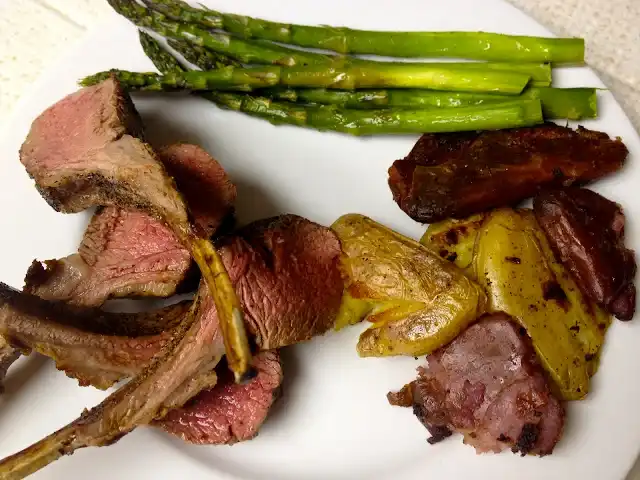Cooking a rack of lamb might sound fancy, but it’s easier than you think. This recipe keeps things simple, focusing on rich, natural flavors that shine without extra fuss.
The lamb is seared until golden brown, then finished in the oven to keep it juicy and tender.
Paired with crispy smashed potatoes and roasted asparagus, it’s a meal that feels special without requiring hours in the kitchen.
The beauty of this dish is in the balance—crunchy, golden potatoes contrast with the soft, juicy lamb, while the asparagus adds a fresh, slightly smoky bite.
Every part of the recipe is straightforward, using just a handful of good-quality ingredients to bring out the best in each component.
Whether you’re cooking for a small gathering or treating yourself to something special, this meal delivers bold flavors with minimal effort. Let’s break it down step by step.
Table of Contents
ToggleRack Of Lamb With Crispy Smashed Potatoes And Roasted Asparagus Recipe
Ingredients
For The Rack Of Lamb
- 1 rack of lamb (about 8 ribs)
- 2 tablespoons olive oil
- Salt and black pepper, to taste
For The Crispy Smashed Potatoes
- 1 pound baby potatoes (fingerling, new, or any small variety)
- 4 cups chicken broth (or salted water for a vegetarian version)
- 2 to 3 tablespoons olive oil
- Salt and black pepper, to taste
Instructions
For The Roasted Asparagus
- Follow the instructions from my roasted asparagus recipe.
Crispy Smashed Potatoes
- Wash the potatoes thoroughly and place them in a pot. Pour in the chicken broth (or salted water) and bring to a gentle boil over medium-high heat.
- Cook until the potatoes are fork-tender, about 15 to 20 minutes. Drain and let them cool slightly.
- Place the potatoes on a flat surface. Using the back of a spoon or a clean towel-covered hand, gently press down to flatten them slightly while keeping them intact.
- Heat olive oil in a large frying pan over medium heat.
- Arrange the smashed potatoes in the pan, leaving space between them. Cook until golden brown and crispy on one side, then carefully flip and crisp up the other side.
- Sprinkle with salt and black pepper, then transfer to an oven-safe dish. Keep warm in a 200°F (95°C) oven until serving time.
Pan-Seared And Oven-Finished Rack Of Lamb
- Trim any thick fat from the lamb rack, ensuring you also remove the silver membrane for better texture.
- Pat the lamb dry with a paper towel—this helps achieve a perfect sear. Generously season all sides with salt and black pepper.
- Preheat the oven to 425°F (220°C). Heat two tablespoons of olive oil in an oven-safe frying pan over medium heat.
- Place the lamb rack in the hot pan, meat side down. Sear for about 3 to 4 minutes until deeply browned. Flip and sear the other side briefly.
- Return the lamb to its meat side down position and transfer the pan to the oven. Roast for about 11 to 15 minutes, depending on your preferred doneness (11 minutes for medium-rare).
- While the lamb is roasting, place the asparagus in the toaster oven.
- Once the lamb is done, remove it from the oven and transfer it to a cutting board. Let it rest for at least 5 minutes before slicing.
- Cut between the bones to create individual chops and serve alongside the crispy smashed potatoes and roasted asparagus.

How To Choose A Good Rack Of Lamb?
Picking the right rack of lamb makes all the difference in how your dish turns out. Look for these key signs to ensure you get the best quality:
- Color: Fresh lamb should have a vibrant pink to red color. Avoid any pieces that look dull or brownish.
- Marbling: A little fat marbling throughout the meat adds flavor and keeps it juicy while cooking.
- Fat Cap: The outer fat layer should be white and firm, not yellow or soft. Too much fat needs trimming, but some is needed for flavor.
- Bone Exposure: If buying pre-trimmed (French-trimmed) lamb, the bones should be clean and smooth without ragged edges.
- Fresh Smell: Lamb should have a mild, fresh scent. If it smells sour or overly strong, it’s not fresh.
- Firm Texture: Press the meat gently—if it bounces back, it’s fresh. If it feels mushy or sticky, avoid it.
Always buy lamb from a trusted butcher or a store known for high-quality meat. If possible, go for grass-fed lamb, as it tends to have better flavor and texture.
How To Trim A Rack Of Lamb Properly?
Trimming a rack of lamb ensures even cooking and a more enjoyable bite. If your rack isn’t already cleaned up, follow these steps:
- Remove Excess Fat: Use a sharp knife to trim the thick layer of fat on top. Leave a thin layer for flavor, but too much fat can make the meat greasy.
- Expose the Bones (Frenching): If you prefer a clean, restaurant-style look, scrape the meat and fat off the exposed rib bones using the back of a knife. This makes the rack look neater and easier to handle.
- Trim the Silver Skin: The tough, silvery membrane on the meat should be carefully removed, as it won’t break down during cooking. Slide a knife under it and peel it off.
- Check for Loose Pieces: Remove any small, hanging bits of meat or fat that might burn or cook unevenly.
How To Get A Perfect Sear On Lamb?
A well-seared rack of lamb has a deep golden crust that locks in juices and adds rich flavor. Follow these simple steps for the best results:
- Pat It Dry: Moisture prevents a good sear, so use paper towels to dry the lamb completely before cooking.
- Season Well: Generously coat all sides with salt and pepper to enhance flavor.
- Use the Right Pan: A heavy pan like cast iron holds heat well and gives a better crust.
- Heat the Oil First: Add a small amount of olive oil to the pan and let it get hot before placing the lamb inside. The oil should shimmer but not smoke.
- Don’t Move It Too Soon: Place the lamb meat-side down and let it sear undisturbed for about 3 to 4 minutes. Moving it too early prevents proper browning.
- Flip Once: Turn the lamb to sear the other side, but avoid flipping it back and forth.
Getting the sear right not only makes the lamb taste amazing but also gives it a beautiful, professional look.
How Long Should You Cook A Rack Of Lamb In The Oven?
The exact cooking time depends on the thickness of the meat and how done you want it. Here’s a general guideline:
- At 425°F (220°C):
- Medium-rare: 11-12 minutes
- Medium: 13-14 minutes
- Medium-well: 15-17 minutes
Always preheat the oven before placing the lamb inside. After searing, transfer the rack to the oven and cook it for the recommended time based on your preference.
What Temperature Should Lamb Be Cooked To?
Using a meat thermometer is the best way to check doneness. Insert it into the thickest part of the lamb and check these temperatures:
- Rare: 120°F (49°C) – Cool red center
- Medium-rare: 125-130°F (52-54°C) – Warm red center
- Medium: 135°F (57°C) – Pink center
- Medium-well: 145°F (63°C) – Slightly pink center
- Well-done: 150°F+ (65°C+) – No pink, fully cooked
Lamb tastes best when it’s still juicy, so medium-rare to medium is ideal. Avoid overcooking, as it can turn tough and dry.

Why Let The Lamb Rest Before Slicing?
Resting the meat might seem like a small step, but it makes a huge difference. Here’s why:
- Locks in Juices: When lamb comes out of the oven, the juices inside are still moving. Resting allows them to settle, so they don’t run out when you cut into it.
- Keeps It Tender: Cutting too soon makes the meat lose moisture, making it drier. A few minutes of rest keeps it soft and juicy.
- Easier to Slice: Hot meat is harder to cut cleanly. Resting helps it firm up slightly, giving you neater slices.
Let the lamb sit for about 5 to 10 minutes before cutting. Cover it loosely with foil to keep it warm without trapping too much steam. This simple step ensures every bite is flavorful and tender.
What Are Some Good Sauces To Serve With Rack Of Lamb?
A well-made sauce can take rack of lamb to the next level by adding richness, freshness, or a hint of spice. Here are some great options that pair beautifully with the meat:
- Mint Sauce: A classic choice, made with fresh mint, vinegar, sugar, and a bit of salt. It adds a bright, slightly tangy contrast to the richness of lamb.
- Garlic Herb Butter: Melted butter mixed with garlic, parsley, and thyme gives a simple yet flavorful coating that enhances the lamb’s natural taste.
- Dijon Mustard Sauce: A creamy blend of Dijon mustard, honey, and a touch of vinegar provides a slightly tangy, mildly spicy kick.
- Chimichurri: This fresh, herby sauce made with parsley, cilantro, garlic, olive oil, and vinegar adds a zesty, slightly spicy touch.
- Tzatziki: A cool yogurt-based sauce with cucumber, garlic, and lemon that balances the lamb’s warmth with a refreshing contrast.
Choosing the right sauce depends on the flavors you enjoy. If you like something fresh, go for mint or chimichurri. For a more indulgent touch, try garlic butter or a wine reduction.
Can This Meal Be Made Ahead Of Time?
Yes, you can prepare parts of this meal in advance to save time, but some steps should be done fresh for the best taste. Here’s what you can do ahead:
- Trimming the Lamb: Clean and trim the fat a day before cooking. Keep it wrapped in the fridge.
- Seasoning: Coat the rack of lamb with salt, pepper, and herbs a few hours before cooking to let the flavors soak in.
- Smashed Potatoes: Boil and smash the potatoes ahead of time, then store them in the fridge. When ready to serve, just fry them until crispy.
- Asparagus: Trim and season the asparagus in advance so it’s ready to roast.
What shouldn’t be done ahead: Searing and roasting the lamb should be done fresh for the best texture. If you cook the lamb too early, it can lose moisture when reheated.
How Do You Store And Reheat Leftovers Without Losing Texture?
To keep leftover lamb, potatoes, and asparagus tasting great, follow these storage and reheating tips:
Storing Leftovers:
- Lamb: Wrap it tightly in foil or store it in an airtight container. Keep it in the fridge for up to 3 days.
- Smashed Potatoes: Store in a container with a lid. If stacked, place parchment paper between them to prevent sticking.
- Asparagus: Keep in an airtight container, but eat within a day or two for the best freshness.
Reheating Without Losing Texture:
- Lamb: Avoid using a microwave, as it makes the meat tough. Instead, warm it in a 300°F (150°C) oven for about 10 minutes, or in a covered pan on low heat.
- Smashed Potatoes: Reheat in a frying pan with a little oil until crispy again. The oven also works at 375°F (190°C) for 10 minutes.
- Asparagus: Warm it in the oven for a few minutes or briefly toss it in a pan to restore some crispness.
You May Also Like To Check Out These Posts
- 65 Best Easter Dinner Ideas For A Perfect Holiday Meal
- Traditional Greek Easter Bread (Tsouréki)
- Easter Carrot Chocolate Covered Strawberries
- Easter Meat Pie
- Soft Hot Cross Buns
- Sicilian Easter Cookies With Eggs
- Italian Easter Anise Cookies
- Greek Lamb And Feta Burgers
- Air Fryer Lamb Chops
- Grilled Lamb Chops
- Pan-Seared Lamb Chops
- Bacon Cheeseburger Meatloaf











